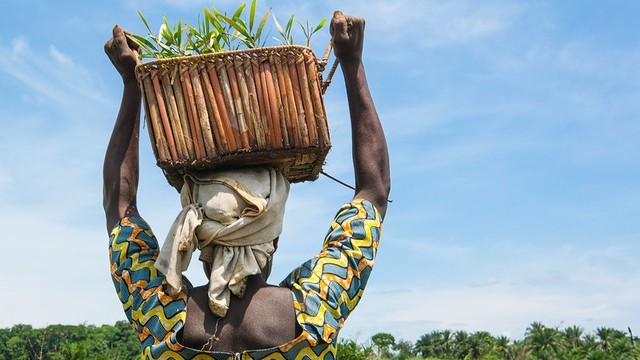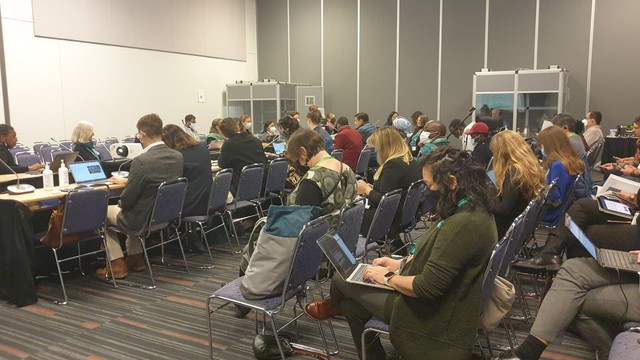The 30x30 target: more opportunity, less threat than expected?
Amid mixed views of the final form of the 30x30 target agreed at the CBD COP15, Orla Corbisiero and Phil Franks review the reactions of many organisations that support Indigenous Peoples and local communities (IP and LCs) to consider whether the target presents more of an opportunity and less of a threat to IP and LCs than they had anticipated prior to COP15.



Farmer in Kwale County, Kenya (Photo: Denis Onyodi/KRCS, via Flickr, CC BY-NC 2.0)
Target 3 of the post-2020 Global Biodiversity Framework (GBF) – also called the 30x30 target – is the world’s most ambitious conservation target to date.
Aiming to conserve 30% of global land and seas by 2030, it provides an opportunity for Indigenous Peoples and local communities (IP and LCs) to be partners, and often leaders, in conservation on a much larger scale and fairer basis. But many global and other top-down conservation targets have in the past had negative impacts on IP and LCs, including their eviction from traditional lands, loss of key and resource and human rights abuses.
So, is this new target any different?
Before the UN biodiversity conference (COP15), we analysed statements from over 30 organisations, some of whom opposed the 30x30 target, to understand their social concerns around it. Here, we summarise the common themes emerging across organisations and explore their reactions since COP15.
IP and LC rights to lands, territories and resources
Leading up to COP15, the most common concern about the 30x30 target was around IP and LC rights to lands, territories and resources. For IP and LC-allied organisations such as Survival International, Rainforest Foundation UK, Minority Rights Group, and the Forest People’s Programme, these concerns were their main reason for opposing the target.
Many organisations have welcomed the inclusion of respect for these rights in the 30x30 and related participation targets. The International Indigenous Forum on Biodiversity’s (IIFB’s) closing statement at COP15 praised the GBF’s recognition of the distinct nature of Indigenous Peoples land, territories and resources, while for the Global Forest Coalition, the main victory is that Indigenous territories were not included as a type of conservation area alongside protected areas and other effective area-based conservation measures (OECMs), allowing Indigenous People to choose how their contribution to conservation is classified.
But the reaction of Rainforest Foundation UK (PDF) and Amnesty International shows they see the 30x30 target as a missed opportunity that does not meet IP and LC demands (PDF) for categorising their territories as distinct from protected areas and OECMs.
Human rights
Before COP15, many IP and LC-supporting organisations – including IIFB, the Association of Peul Women and Autochthonous Peoples of Chad (AFPAT), Asia Indigenous Peoples Pact (AIPP) and Te Mau – supported the 30x30 target, provided it respected IP and LC human rights. Conservation groups such as World Wildlife Fund (WWF), the International Union for Conservation of Nature (IUCN), The Nature Conservancy, the Wildlife Conservation Society (WCS), and the National Geographic also supported this stance.
But while the GBF states that implementation of all aspects should respect, protect, promote and fulfil human rights, there is no monitoring framework for this. And for human rights safeguards to have any teeth, they need to be in the targets and the monitoring framework for these targets.
As COP15 closed, IIFB spokesperson Viviana Figueroa, from Argentina’s Omaguaca-Kolla peoples, praised the inclusion of Indigenous rights in the 30x30 target as a significant step towards avoiding human rights violations. The Forest Peoples Programme amplified this. But neither the 30x30 target nor the earlier COP14 guidance (PDF) that interprets the equitable governance element of the target are clear on whether ‘rights’ include human rights as well as rights to lands, territories and resources. Lawyers seem split on this.
Although the Rainforest Foundation UK does not support the 30x30 target, it welcomed the removal of ‘strictly protected’ areas from the text due to connotations with human rights abuses. The Global Forest Coalition reminds us that governments should focus on including equitable governance – that is, quality over quantity. Amnesty International, on the other hand, disputes that the 30x30 target will ensure respect of IP and LC human rights.
Financing
Ahead of COP15, organisations agreed that more resources were needed to achieve the 30x30 target, with IIFB, AFPAT, AIPP, the Mesoamerican Alliance of Peoples and Forest, African Youth Summit, Nature Conservancy, Campaign for Nature and IUCN all calling for improved, more equitable pathways to channel finance direct to IP and LCs.
And while the GBF and donors seem supportive of channelling more resources directly to IP and LCs, there is no requirement to monitor or report on this, and few organisations have commented on the financial implications of the ‘equitably governed’ and ‘respecting rights’ elements of the 30x30 target.
In their closing statement – later reinforced by the Forest Peoples Programme – IIFB gently, yet significantly, reminded those present that recognising IP and LC efforts also means getting more finance to them through less bureaucratic financial mechanisms. There are concerns that inadequate financial mechanisms for supporting IP and LC-led conservation will simply prolong business-as-usual conservation.
The Global Forest Coalition compares the GBF to the Green Climate Fund. Both are within the Global Environment Facility (GEF), which the coalition maintains has become dominated by private sector corporations, undermining the achievement of climate goals. Although the GEF has a Small Grants Programme that provides funds to community-based organisations, can it or a similar mechanism get the necessary volumes of funding to IP and LCs?
Participation in decision-making
Before COP15, many organisations cited IP and LC participation in decision-making (target 22) as a crucial success factor for the 30x30 target. AFPAT demanded that governments include Indigenous Peoples in planning and implementing every conservation initiative, while the Global Youth Biodiversity Network asked for meaningful youth engagement. And the Nature Conservancy, Campaign for Nature, WWF and IUCN, among others, urged effective engagement of IP and LCs and other key stakeholders.
Target 22 looks like a big success for meaningful participation, and now, significantly, also includes access to information and justice for IP and LCs in relation to biodiversity conservation.
IIFB praised the GBF’s recognition of Indigenous Peoples’ full and equitable participation in implementing the framework and their role in conserving biodiversity. In its closing statement, it confirmed its intention to develop partnerships with governments and other stakeholders, and asked for sufficient resources to ensure IP and LC participation. And the new gender equality target (target 23) places special emphasis on women’s participation in decision-making.
However, as with human rights, targets 3 and 22 lack an accountability mechanism. The GBF monitoring framework has not a single indicator for participation, access to information or access to justice in area-based conservation beyond conducting governance assessments.
Looking forward
From a rights, financing and participation perspective, the outcome of negotiations on the final text of the 30x30 and related targets is in several respects better than expected. Key successes include a strong emphasis on IP and LC rights to lands, territories and resources in several targets, the inclusion of equitable governance in the 30x30 target, and access to information and justice alongside equitable and inclusive participation in decision-making in Target 22, and the gender equality target.
However, some key concerns remain, notably that the 30x30 target lacks an adequate financing mechanism for IP and LC contributions and there is no clarity on whether human rights are covered under its equitable governance and rights elements.
A key next step for the GBF is the development of the robust monitoring framework for COP16 in two years’ time. The indicators must provide practical measures of respect for rights, (including human rights), participation, access to information and justice, and financing that can help ensure that the 30x30 target is indeed a real opportunity to advance IPLC-led conservation.



